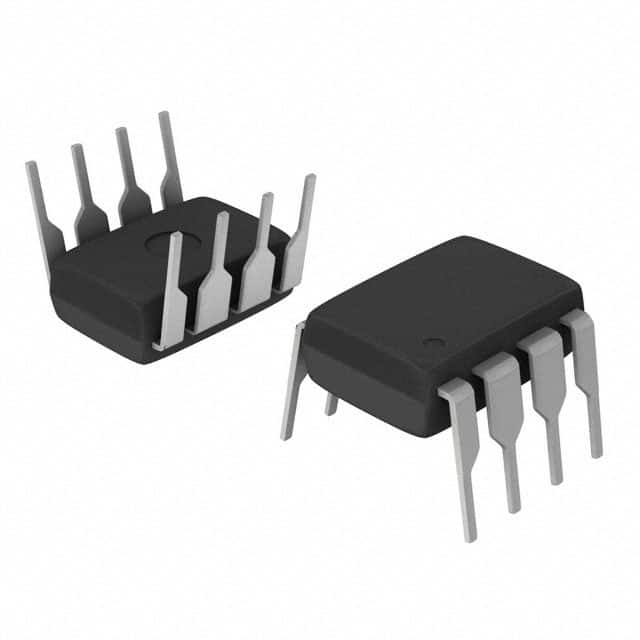Xem thông số kỹ thuật để biết chi tiết sản phẩm.

MCP3001-I/P
Product Overview
- Category: Integrated Circuit (IC)
- Use: Analog-to-Digital Converter (ADC)
- Characteristics: High-resolution, low-power consumption
- Package: DIP (Dual In-line Package)
- Essence: Converts analog signals to digital data
- Packaging/Quantity: Available in tubes of 25 units
Specifications
- Resolution: 10-bit
- Number of Channels: 1
- Conversion Time: 200 µs
- Input Voltage Range: 0V to Vref
- Supply Voltage Range: 2.7V to 5.5V
- Operating Temperature Range: -40°C to +85°C
Pin Configuration
The MCP3001-I/P has a total of 8 pins arranged as follows:
┌───┬───┐
│ 1 │ 8 │
│ │ │
│ │ │
│ │ │
│ │ │
│ │ │
│ │ │
│ 4 │ 5 │
└───┴───┘
Pin Description: 1. VDD: Supply Voltage 2. VREF: Reference Voltage 3. AGND: Analog Ground 4. VIN: Analog Input 5. CLK: Clock Input 6. CS: Chip Select Input 7. DOUT: Digital Output 8. DGND: Digital Ground
Functional Features
- High-resolution ADC with 10-bit resolution
- Low-power consumption for energy-efficient applications
- Single-ended input configuration
- SPI (Serial Peripheral Interface) communication protocol
- On-chip sample and hold circuitry for accurate conversions
Advantages and Disadvantages
Advantages: - High resolution allows for precise analog-to-digital conversions - Low-power consumption extends battery life in portable devices - Single-ended input configuration simplifies circuit design - SPI communication protocol enables easy integration with microcontrollers
Disadvantages: - Limited to a single analog input channel - Relatively slower conversion time compared to higher-end ADCs - Requires an external reference voltage for accurate conversions
Working Principles
The MCP3001-I/P is an analog-to-digital converter that converts analog signals into digital data. It utilizes a successive approximation register (SAR) architecture to achieve 10-bit resolution. The analog input voltage is compared to the internal reference voltage, and the converter determines the digital representation of the input signal.
The conversion process is controlled by the clock input (CLK) and chip select input (CS). The digital output (DOUT) provides the converted data in serial format. The MCP3001-I/P operates on a supply voltage (VDD) and requires a stable reference voltage (VREF) for accurate conversions.
Detailed Application Field Plans
The MCP3001-I/P is widely used in various applications, including:
- Sensor Interface: It can be used to interface with sensors such as temperature sensors, pressure sensors, and light sensors, converting their analog outputs into digital data for further processing.
- Data Acquisition Systems: The MCP3001-I/P is suitable for data acquisition systems that require high-resolution analog-to-digital conversions, such as industrial monitoring systems and scientific instruments.
- Portable Devices: Its low-power consumption makes it ideal for battery-powered devices like handheld meters, medical devices, and portable audio equipment.
- Communication Systems: The MCP3001-I/P can be used in communication systems for converting analog signals from audio inputs or line inputs into digital data for transmission or processing.
Detailed and Complete Alternative Models
- MCP3002-I/P: Similar to the MCP3001-I/P, but with 2 analog input channels.
- MCP3004-I/P: Provides 4 analog input channels and 10-bit resolution.
- MCP3201-CI/P: Offers higher resolution (12-bit) and a faster conversion time compared to the MCP3001-I/P.
These alternative models provide different channel configurations, resolutions, and features to suit specific application requirements.
Word count: 529 words
Liệt kê 10 câu hỏi và câu trả lời thường gặp liên quan đến ứng dụng MCP3001-I/P trong giải pháp kỹ thuật
What is the MCP3001-I/P?
The MCP3001-I/P is a 10-bit analog-to-digital converter (ADC) that can be used to convert analog signals into digital data for processing in microcontroller-based systems.What is the supply voltage range for the MCP3001-I/P?
The supply voltage range for the MCP3001-I/P is typically between 2.7V and 5.5V.What is the maximum sampling rate of the MCP3001-I/P?
The maximum sampling rate of the MCP3001-I/P is 200 kilosamples per second (ksps).Can the MCP3001-I/P be used with a Raspberry Pi?
Yes, the MCP3001-I/P can be interfaced with a Raspberry Pi using its SPI interface.What is the resolution of the MCP3001-I/P?
The MCP3001-I/P has a resolution of 10 bits, providing 1024 possible digital values for the analog input.How many analog input channels does the MCP3001-I/P have?
The MCP3001-I/P has a single analog input channel.Can the MCP3001-I/P be used in battery-powered applications?
Yes, the MCP3001-I/P's low power consumption makes it suitable for battery-powered applications.What is the typical accuracy of the MCP3001-I/P?
The MCP3001-I/P has a typical integral non-linearity (INL) of ±1 LSB and differential non-linearity (DNL) of ±1 LSB.Is the MCP3001-I/P suitable for industrial temperature range applications?
Yes, the MCP3001-I/P is designed to operate over an industrial temperature range of -40°C to +85°C.Can the MCP3001-I/P be used in automotive electronics?
Yes, the MCP3001-I/P's wide supply voltage range and industrial temperature range make it suitable for automotive electronics applications.

